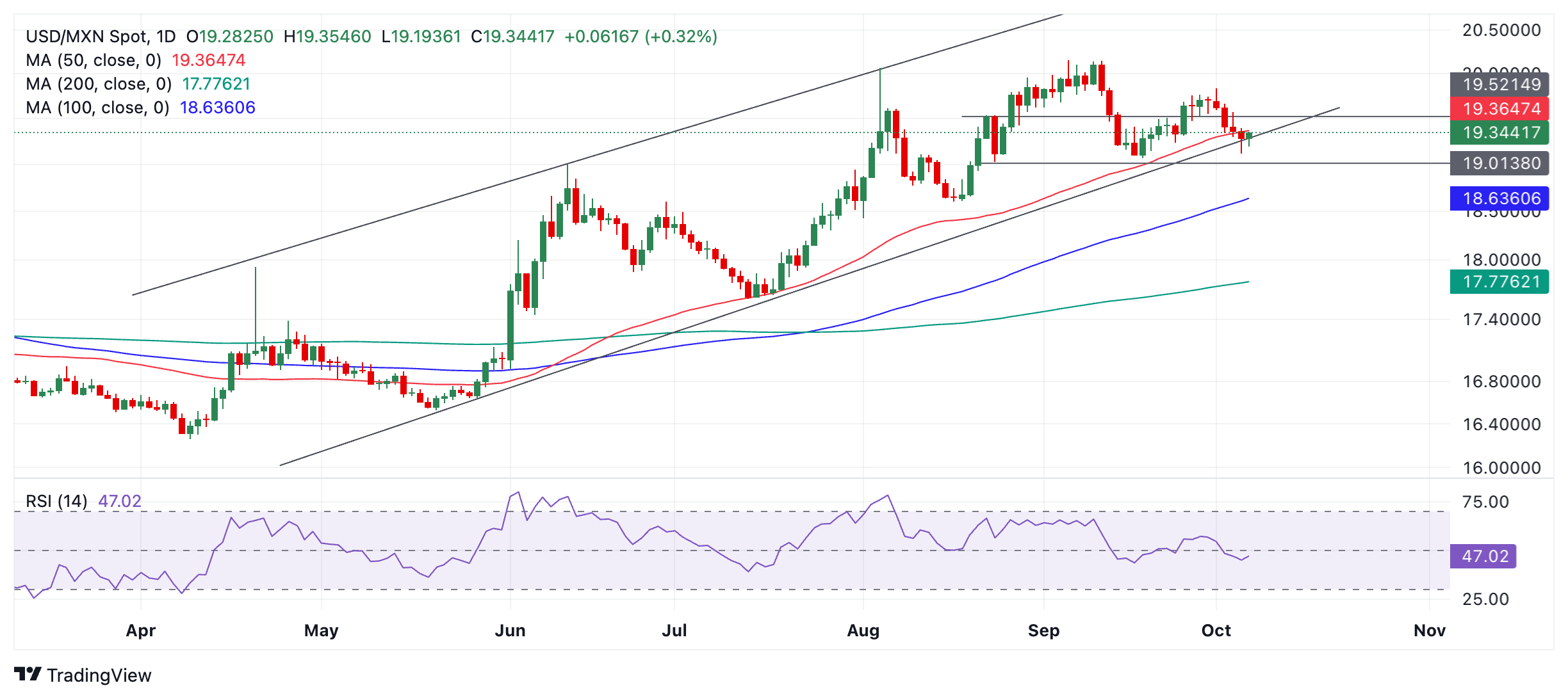- The Mexican peso falls on Monday.
- The MXN’s decline is limited by positive US and domestic data, suggesting a strong export outlook.
- Judges’ actions to block contentious reforms to the judiciary further support the MXN.
- USD/MXN breaks below the key 50-day SMA and tests the bottom of a major ascending channel.
The Mexican Peso (MXN) declines across its key pairs on Monday, however the decline remains limited by a combination of a more benign outlook for its most significant trading partner, the United States (US) – following employment data in US better than expected – as well as recent and robust national data from Mexico.
Data on Friday showed that U.S. Nonfarm Payrolls (NFP) beat expectations by a wide margin in September, rising by 254,000 when economists only expected an increase of 140,000, according to data from the Bureau of Labor Statistics ( BLS). Additionally, the unemployment rate fell to 4.1% from 4.2% when markets feared the opposite. Overall, the data showed that the US economy remains in good shape, avoiding fears of a “hard landing.”
In Mexico, meanwhile, both auto production and exports increased in September. Production rose 11.71% from 8.30% the previous month, and exports rose 4.8%, compared to 1.7% in August. That said, Mexico’s unemployment rate in August reached 3.0%, up from 2.9% in July, according to data from the National Institute of Statistics and Geography (INEGI).
Mexican Peso Rebounds as Sheinbaum Fears Ease, Judges Block New Laws
The Mexican Peso is further supported by the easing of investor concerns regarding the radical reforms proposed by former President Andrés Manuel López Obrador (AMLO). Many investors consider the reforms “anti-market.” This caused a massive sell-off of Mexican financial assets after the re-election of his Morena-led coalition in June. It was also partly responsible for the peso’s weakness by 10% in the months after the election.
Although new President Claudia Sheinbaum has said she generally supports AMLO’s radical reform agenda, markets appear to be more optimistic about its implementation under her watch, according to FXStreet analyst Christian Borjon Valencia.
The first key reform was voted at the end of AMLO’s term in September. Calls for the election of judges instead of their appointment. It has been heavily criticized for undermining the independence of the judiciary and, as a result, scaring away potential foreign investors key to Mexico’s growth as a nearshoring destination.
The Mexican Peso gained ground at the end of last week, however, after Mexico’s Supreme Court of Justice voted to delay the implementation of the new judicial reforms, so that they could re-examine and possibly make revisions to the new laws. Their move was backed by the legal principle that laws should not jeopardize the independence of the judiciary.
Over the weekend, the National Electoral Institute (INE) challenged an additional brake on the implementation of AMLO’s judicial reforms, this time by several district judges. The INE appealed to the Electoral Tribunal of the Judicial Branch of the Federation (TEPJF) asking to revoke the blockade, which seeks to inhibit the elections for new judges scheduled for June 1, 2025, according to El Financiero.
Technical Analysis: USD/MXN breaks below the 50-day moving average
USD/MXN breaks below the 50-day SMA, a key line for traders, and tests the bottom of a medium-term ascending channel.
USD/MXN Daily Chart
USD/MXN is expected to find support at the base of the channel, and there is a chance it could recover and start rising again. The medium and long-term trends remain bullish, and given the technical analysis principle that “the trend is your friend”, the probabilities favor a recovery and continuation upwards.
However, the short-term trend is bearish, and the pair has broken below the 50-day SMA, a key level and the first obstacle for further declines. A decisive breakout of the channel would put the medium-term uptrend in USD/MXN at risk.
A decisive breakout would be characterized by a longer-than-usual bearish candle that cleanly pierced the channel line and closed near its low. Such a breakout would likely continue down, towards an initial downside target at 19.00 (Aug 23 low, round number) and then 18.60, the 100-day SMA level.
economic indicator
Non-farm payrolls
The most important result contained in the employment report is the monthly change in non-farm payrolls published by the US Department of Labor. The report publishes job creation estimates for the previous month and revisions to the data for the previous two months. Monthly changes in payrolls can be very volatile and the publication of this report generates high volatility in the dollar. A result above the market consensus is bullish for the dollar, while a result below expectations is bearish.
Last post:
Fri Oct 04, 2024 12:30
Frequency:
Monthly
Current:
254K
Dear:
140K
Previous:
142K
Fountain:
US Bureau of Labor Statistics
The monthly US employment report is considered the most important economic indicator for currency traders. Published on the first Friday following the reported month, the change in the number of employees is closely related to the overall performance of the economy and is monitored by policymakers. Full employment is one of the Federal Reserve’s mandates and it considers the evolution of the labor market when setting its policies, which affects currencies. Despite several leading indicators shaping estimates, Non-Farm Payrolls tend to surprise markets and trigger substantial volatility. Actual numbers that beat consensus tend to be bullish for the USD.
Source: Fx Street
I am Joshua Winder, a senior-level journalist and editor at World Stock Market. I specialize in covering news related to the stock market and economic trends. With more than 8 years of experience in this field, I have become an expert in financial reporting.








